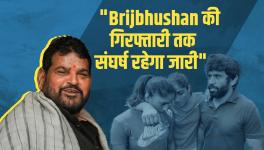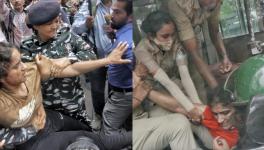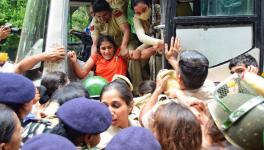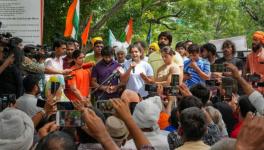Tokyo Olympics: A Six-minute Look at the Real Bajrang Punia
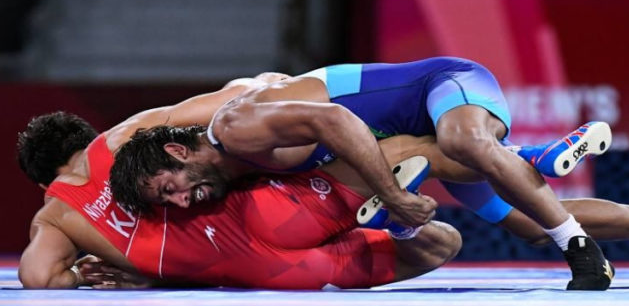
Bajrang Punia scores from a takedown in his 65 kg freestyle bronze medal bout against Daulet Niyazbekov or Kazakhstan at the Tokyo Olympics on Saturday (Pic: News135, Twitter).
The message was loud, clear... It was visible too. Bajrang Punia paused on the corridor leading onto the mat — in front of the camera capturing the approaching athlete — not just for the broadcast-mandated ritual we have seen all wrestlers follow. He was announcing his intent ahead of the 65kg bronze-medal bout against Daulet Niyazbekov of Kazakhstan. Whatever it is that was weighing the Indian champion down in the previous rounds and the semifinal on Friday were left in the warm-up hall, the message said. Discarded along with the knee strapping. Bajrang was walking out without the heavy knee support he had the previous day, one that was helping him keep that trouble in check. A message for his opponent and the world. A message to his subconscious too. Knee injury? What? Where?
It was almost pulp Bollywood, the entry: A hero walking out for that final showdown with the villain after shedding those blood-soaked bandages, apprehensions, and even logic. This was the defining moment in the plot, the endgame. And Niyazbekov, the villain that ended Bajrang’s run at the 2019 World Championships, stood across him in red, ready for his wily game.
Also Read | On for the Gold Quest: The Big Stakes in Indian Women’s Hockey Team’s Tokyo Show
This was no movie though. The stunt was real, and, in the bout Bajrang brought out a bit of his real self, the version that saw him become the world’s best in the division. He never backed off the pedal, he never let the opponent step it up either. Such was the dominance: A masterclass in attacking wrestling, but with restraint clever enough that it was hard to notice the shift in intensity Bajrang was bringing about through the bout. Subtle. Very Subtle.
He scored twice in the opening period, the first via a passivity penalty and the other when Niyazbekov stepped out. But it was not a brawn-induced pushout. Niyazbekov went out because Bajrang was constantly going for his legs, not blindly, but with variations in body balance and pace — an hallmark of his style of fighting — keeping the Kazakh guessing, and forcing him into frantic and draining evasive moves.
The first three minutes of action gave us a fair idea that this Saturday night Bajrang was not the weary Friday worker, who, in the opening rounds, trudged his way home, and lay deflated in the semis. Almost done!
Also Read | The Pain Of Bajrang Punia in His Quest for Olympic Success
At half time on Saturday, home was still far from Bajrang. He knew that he had to work hard, keep up the tempo, in the final three minutes. The tipping point for Niyazbekov came soon enough, at exactly the one-and-a-half minutes mark of the second period. There are only very few wrestlers who could withstand this kind of attacking intent from an opponent. That too an opponent who is as seasoned as Bajrang.
Till that point, Niyazbekov had to use all his agility, experience, and even flexibility to wriggle out of Bajrang’s attempts to take him down. Finally, he could not. Barang transitioned from a double-leg attempt to the Kazakh’s left leg, got it secure in an ankle hold and pushed on for a takedown. 4-0. And counting…
The action restarted and if we thought Bajrang was going to let off and protect his lead we were in for a pleasant surprise. Ten seconds later, Bajrang had Niyazbekov’s leg, this time the right one. Ankle lock again but a different move, a side twist to force his opponent down for a takedown. 6-0. And counting… Knee injury? What knee injury? Injuries be damned, pain all but subdued in the deep recesses of a wrestling mind who was sensing victory now.
Also Read | Tears of Hope, Screams of Justice: This Indian Women’s Hockey Team Inspires Us to Change; It’s Time We Did
There was a little over 30 seconds left between Bajrang and his medal when he went for it again. Left leg now. And no guesses there. The ankle again. This was the easiest takedown Bajrang landed on Saturday. 8-0.
And that is where the scores remained.
Bajrang fulfilled his potential, though he ended up a couple of rungs below what he had set out to be. In the coming days, we may get an idea as to who, or rather, what were his opponents — the ones off the mat — which the 27-year-old had to contend with to earn that Bronze.
Clearly, he had to fight himself too, to get that old Bajrang out for the last six minutes of his campaign in Tokyo, overcoming whatever blocks that kept him from unleashing himself earlier in the competition
Click | For More Coverage of the Tokyo Olympics From Newsclick Sports
There is truth in wrestling. There is also this raw and rough beauty in wrestling. The presence of pain. Be it in a loss. Be it in a win. And we would hardly know about it, unless we look between the moves, look at the pauses, the signs, the cringes and the takedowns. Bajrang, however, did not reveal anything. There was no cringe, no panting. Nothing. Just sheer determination and grit.
The beauty of wrestling lies not just in victories but also in knowing how substantial a part of him and his health the wrestler put in line to earn it. That knowledge helps us look at this medal differently, for then it dawns on us that it is indeed golden, regardless of where Bajrang stands in the sport, in the larger dynamics of his weight division, or even the future.
Get the latest reports & analysis with people's perspective on Protests, movements & deep analytical videos, discussions of the current affairs in your Telegram app. Subscribe to NewsClick's Telegram channel & get Real-Time updates on stories, as they get published on our website.













